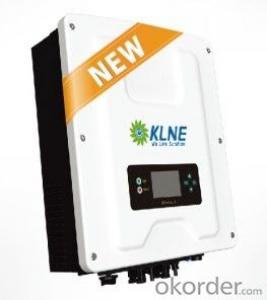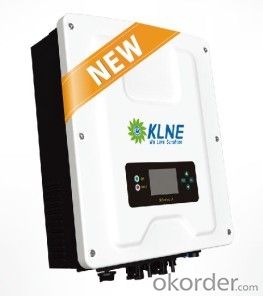Low Cost Solartec D 4000 On Grid Inverter with 2 MPPT WiFi
- Loading Port:
- Shanghai
- Payment Terms:
- TT OR LC
- Min Order Qty:
- -
- Supply Capability:
- 10000 set/month
OKorder Service Pledge
Quality Product, Order Online Tracking, Timely Delivery
OKorder Financial Service
Credit Rating, Credit Services, Credit Purchasing
You Might Also Like
Solartec D 2500,3000,3600,4000,4600,5000
2MPPT Trackers
online monitoring system by integrated WIFI
Integrated DC Switch
Comprehensive protection functions
Graphic display
High efficiency 97.5%
RS 485/RS 232/SolarLog Communication
5 Years warranty
G83,G59,VDE 4105,VDE 0126,CEI
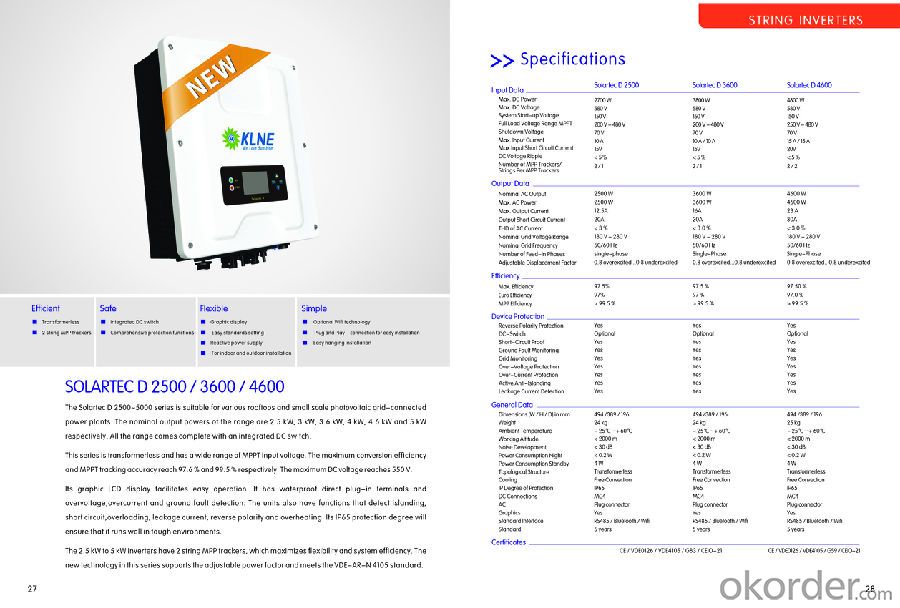
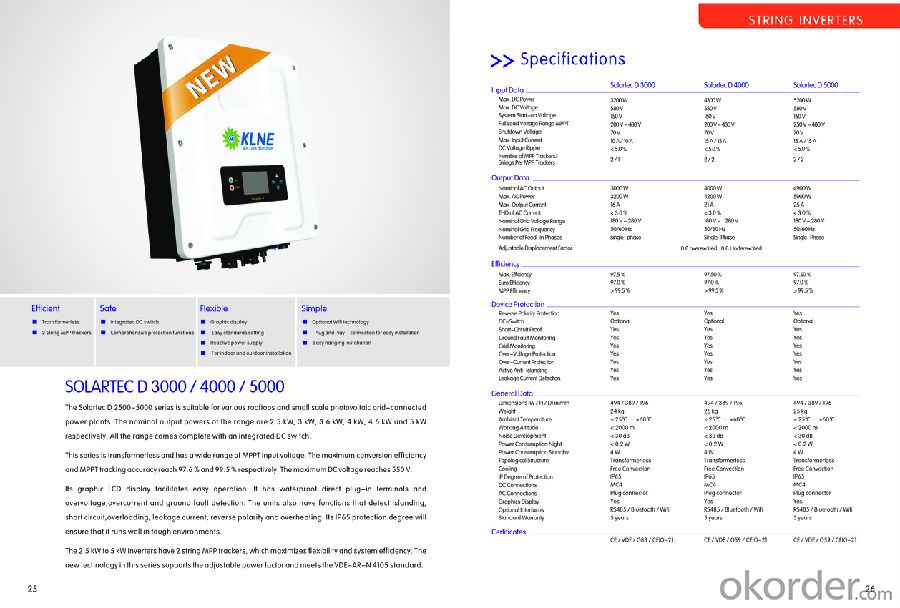
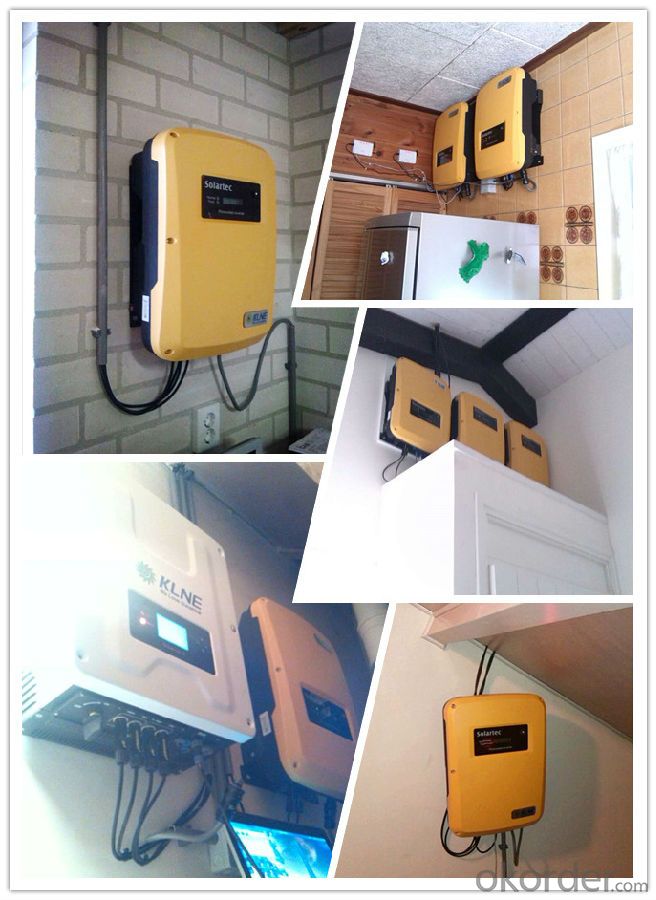
- Q: How do you choose the right voltage rating for a solar inverter?
- When choosing the right voltage rating for a solar inverter, it is important to consider the voltage of the solar panels and the electrical grid. The voltage rating of the inverter should match or be compatible with both of these sources. Additionally, factors such as the maximum power output of the solar panels and the electrical load should also be taken into account to ensure optimal performance and efficiency of the inverter.
- Q: How does a solar inverter handle voltage drop?
- A solar inverter is designed to handle voltage drop by continuously monitoring the voltage level of the solar panels. If the voltage drops below a certain threshold, the inverter adjusts its internal electronics to compensate for the drop and ensure a consistent output voltage. This allows the inverter to maintain optimal performance and efficiency even in situations with voltage fluctuations or drops.
- Q: Can a solar inverter be used in areas with high levels of electrical noise or interference?
- Yes, a solar inverter can be used in areas with high levels of electrical noise or interference. However, it is important to ensure that the inverter is designed to handle such conditions and has appropriate noise filtering mechanisms in place to minimize any potential disruptions or damage caused by the interference.
- Q: How does a solar inverter handle voltage regulation during load changes?
- A solar inverter handles voltage regulation during load changes by continuously monitoring the voltage and adjusting its output accordingly. It uses advanced control algorithms to regulate the voltage and ensure a stable and consistent supply of power to the connected load, even during fluctuations in demand. This allows the inverter to efficiently adapt to changing load conditions and maintain the desired voltage levels.
- Q: What is the role of power ramp rate control in a solar inverter?
- The role of power ramp rate control in a solar inverter is to regulate the rate at which the power output of the solar panels increases or decreases. This control feature helps to ensure a smooth and gradual transition in power generation, thereby preventing sudden fluctuations and potential grid instability. By managing the rate at which power is introduced to the grid, power ramp rate control helps to maintain the stability and reliability of the overall electrical system.
- Q: How does a solar inverter handle voltage dips and swells?
- A solar inverter handles voltage dips and swells by constantly monitoring the incoming voltage from the solar panels and adjusting its output accordingly. When there is a dip in the grid voltage, the inverter compensates by injecting additional power into the system, whereas during voltage swells, it reduces its power output to prevent damage. This dynamic response ensures that the inverter maintains a stable and consistent voltage output, protecting both the solar system and the connected appliances.
- Q: Can a solar inverter be used in conjunction with a battery management system?
- Yes, a solar inverter can be used in conjunction with a battery management system. In fact, combining a solar inverter with a battery management system allows for efficient energy storage and utilization, as the battery management system controls the charging, discharging, and overall management of the batteries, while the solar inverter converts the direct current (DC) power from the batteries into alternating current (AC) power for use in homes or businesses. This integration enables a more sustainable and reliable energy solution by maximizing the use of solar energy and providing backup power during grid outages.
- Q: Can a solar inverter be used with different types of solar panel mounting systems?
- Yes, a solar inverter can be used with different types of solar panel mounting systems. The function of a solar inverter is to convert the direct current (DC) produced by solar panels into alternating current (AC) that can be used to power household appliances or fed into the grid. The compatibility of the inverter with different mounting systems depends on the electrical specifications and requirements of the panels and the inverter. As long as the electrical connections and voltage requirements are met, a solar inverter can be used with various types of solar panel mounting systems such as roof-mounted, ground-mounted, or pole-mounted systems.
- Q: Can a solar inverter be used with a solar-powered remote sensing system?
- Yes, a solar inverter can be used with a solar-powered remote sensing system. A solar inverter is responsible for converting the direct current (DC) generated by solar panels into alternating current (AC) that can be used to power electrical devices. In the case of a solar-powered remote sensing system, the solar inverter can convert the DC power generated by the solar panels into AC power that can be used to operate the remote sensing equipment, ensuring reliable and efficient operation.
- Q: Can a solar inverter be used with solar-powered ventilation systems?
- Yes, a solar inverter can be used with solar-powered ventilation systems. The solar inverter is responsible for converting the direct current (DC) generated by the solar panels into alternating current (AC) that can be used to power various devices and systems, including ventilation systems. By connecting the solar panels to the solar inverter, the AC energy produced can be used to operate the ventilation system, making it an efficient and eco-friendly solution.
Send your message to us
Low Cost Solartec D 4000 On Grid Inverter with 2 MPPT WiFi
- Loading Port:
- Shanghai
- Payment Terms:
- TT OR LC
- Min Order Qty:
- -
- Supply Capability:
- 10000 set/month
OKorder Service Pledge
Quality Product, Order Online Tracking, Timely Delivery
OKorder Financial Service
Credit Rating, Credit Services, Credit Purchasing
Similar products
Hot products
Hot Searches
Related keywords
